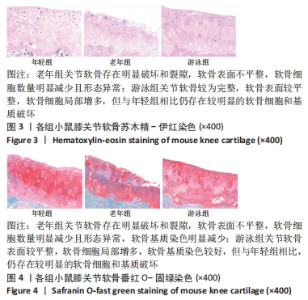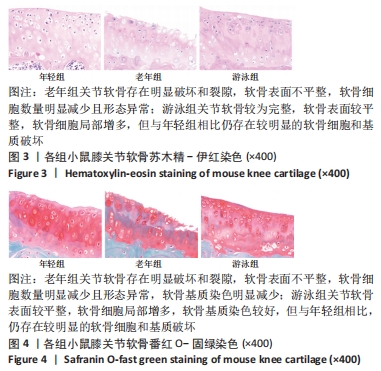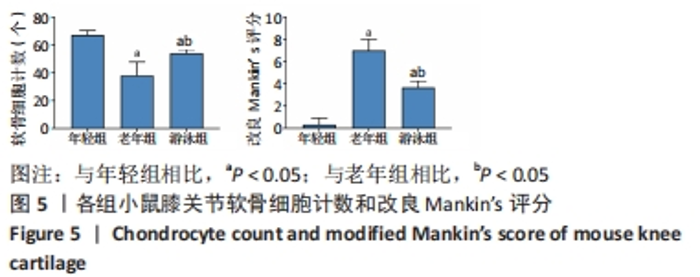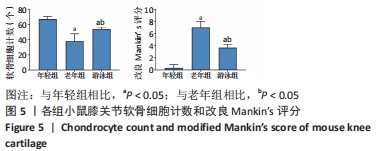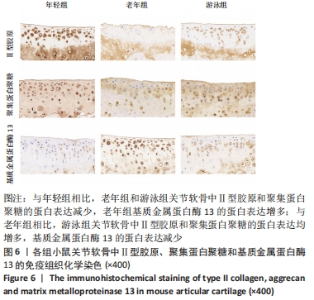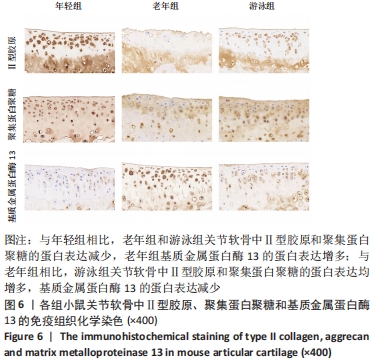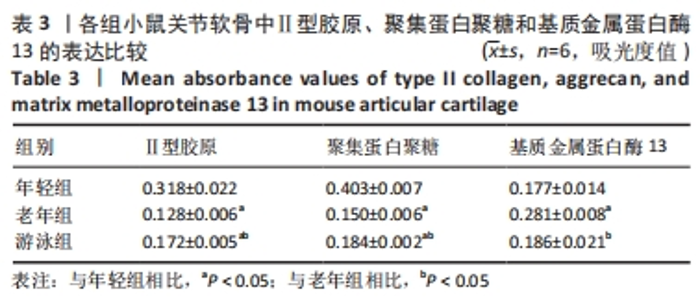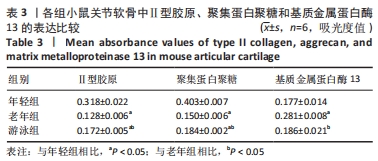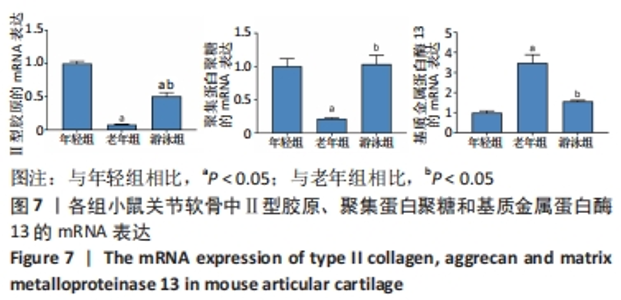Chinese Journal of Tissue Engineering Research ›› 2024, Vol. 28 ›› Issue (20): 3170-3175.doi: 10.12307/2024.353
Previous Articles Next Articles
Cartilage protective effect of swimming exercise in aged mice with knee osteoarthritis
Zhu Shijie1, Yang Yiting1, Cao Yuting1, Zheng Liangdong1, Lin Kaili2, Zhu Rui1
- 1School of Medicine, Yangzhi Rehabilitation Hospital, Tongji University, Shanghai 200092, China; 2Shanghai Ninth People’s Hospital, Shanghai Jiao Tong University School of Medicine, Shanghai 200011, China
-
Received:2023-04-18Accepted:2023-06-15Online:2024-07-18Published:2023-09-09 -
Contact:Zhu Rui, MD, Associate professor, School of Medicine, Yangzhi Rehabilitation Hospital, Tongji University, Shanghai 200092, China -
About author:Zhu Shijie, Master candidate, School of Medicine, Yangzhi Rehabilitation Hospital, Tongji University, Shanghai 200092, China -
Supported by:National Key Research and Development Program, No. 2020YFC2008703 (to ZR)
CLC Number:
Cite this article
Zhu Shijie, Yang Yiting, Cao Yuting, Zheng Liangdong, Lin Kaili, Zhu Rui. Cartilage protective effect of swimming exercise in aged mice with knee osteoarthritis[J]. Chinese Journal of Tissue Engineering Research, 2024, 28(20): 3170-3175.
share this article
Add to citation manager EndNote|Reference Manager|ProCite|BibTeX|RefWorks
| [1] KATZ JN, ARANT KR, LOESER RF. Diagnosis and Treatment of Hip and Knee Osteoarthritis: A Review. JAMA. 2021;325(6):568-578. [2] CORYELL PR, DIEKMAN BO, LOESER RF. Mechanisms and therapeutic implications of cellular senescence in osteoarthritis. Nat Rev Rheumatol. 2021;17(1):47-57. [3] ZENG C, DUBREUIL M, LAROCHELLE MR, et al. Association of Tramadol With All-Cause Mortality Among Patients With Osteoarthritis. JAMA. 2019;321(10):969-982. [4] LIAO Y, REN Y, LUO X, et al. Interleukin-6 signaling mediates cartilage degradation and pain in posttraumatic osteoarthritis in a sex-specific manner. Sci Signal. 2022;15(744):eabn7082. [5] ZHENG L, ZHANG Z, SHENG P, et al. The role of metabolism in chondrocyte dysfunction and the progression of osteoarthritis.Ageing Res Rev. 2021;66:101249. [6] LIN J, JIA S, ZHANG W, et al. Recent Advances in Small Molecule Inhibitors for the Treatment of Osteoarthritis. J Clin Med. 2023;12(5): 1986. [7] 刘静. 中国老年膝关节骨关节炎诊疗及智能矫形康复专家共识[J]. 临床外科杂志,2019,27(12):1105-1110. [8] FERNANDES L, HAGEN KB, BIJLSMA JW, et al. EULAR recommendations for the non-pharmacological core management of hip and knee osteoarthritis. Ann Rheum Dis. 2013;72(7):1125-1135. [9] ARDEN NK, PERRY TA, BANNURU RR, et al. Non-surgical management of knee osteoarthritis: comparison of ESCEO and OARSI 2019 guidelines.Nat Rev Rheumatol. 2021;17(1):59-66. [10] BOWDEN JL, HUNTER DJ, DEVEZA LA, et al. Core and adjunctive interventions for osteoarthritis: efficacy and models for implementation. Nat Rev Rheumatol. 2020;16(8):434-447. [11] KOLASINSKI SL, NEOGI T, HOCHBERG MC, et al. 2019 American College of Rheumatology/Arthritis Foundation Guideline for the Management of Osteoarthritis of the Hand, Hip, and Knee. Arthritis Rheumatol. 2020;72(2):220-233. [12] DANNAWAY J, NEW CC, NEW CH, et al. Aquatic exercise for osteoarthritis of the knee or hip (PEDro synthesis). Br J Sports Med. 2017;51(16):1233-1234. [13] BARTELS EM, JUHL CB, CHRISTENSEN R, et al. Aquatic exercise for the treatment of knee and hip osteoarthritis. Cochrane Database Syst Rev. 2016;3(3):CD005523. [14] AL-HASHEM F, EL KARIB AO, BIN-JALIAH I, et al. Exercise protects against insulin-dependent diabetes-induced osteoarthritis in rats: A scanning electron microscopy study. Ultrastruct Pathol. 2017;41(3):252-257. [15] HSIEH YL, YANG CC. Early intervention of swimming exercises attenuate articular cartilage destruction in a rat model of anterior cruciate ligament and meniscus knee injuries. Life Sci. 2018;212:267-274. [16] XUE T, NING K, YANG B, et al. Effects of Immobilization and Swimming on the Progression of Osteoarthritis in Mice.Int J Mol Sci. 2022;24(1): 535. [17] ZHANG J, QI B, LIU M, et al. Influence of swimming exercise on the expression of apoptotic gene caspase-3 in chondrocytes in osteoarthritis. Am J Transl Res. 2021;13(4):2511-2517. [18] MARTINS GA, DEGEN AN, ANTUNES FTT, et al. Benefits of electroacupuncture and a swimming association when compared with isolated protocols in an osteoarthritis model. J Tradit Complement Med. 2021;12(4):375-383. [19] DA SILVA L A, THIRUPATHI A, COLARES MC, et al. The effectiveness of treadmill and swimming exercise in an animal model of osteoarthritis. Front Physiol. 2023;14:1101159. [20] DAANS M, LUYTEN FP, LORIES RJ. GDF5 deficiency in mice is associated with instability-driven joint damage, gait and subchondral bone changes. Ann Rheum Dis. 2011;70(1):208-213. [21] AIGNER T, COOK JL, GERWIN N, et al. Histopathology atlas of animal model systems – overview of guiding principles. Osteoarthritis Cartilage. 2010;18: S2-S6. [22] ALVES-SIMÕES M. Rodent models of knee osteoarthritis for pain research. Osteoarthritis Cartilage. 2022;30(6):802-814. [23] KAYA S, BAILEY KN, SCHURMAN CA, et al. Bone-cartilage crosstalk informed by aging mouse bone transcriptomics and human osteoarthritis genome-wide association studies. Bone Rep. 2022;18: 101647. [24] ZHANG X, DENG XH, SONG Z, et al. Matrix Metalloproteinase Inhibition With Doxycycline Affects the Progression of Posttraumatic Osteoarthritis After Anterior Cruciate Ligament Rupture: Evaluation in a New Nonsurgical Murine ACL Rupture Model.Am J Sports Med. 2020;48(1):143-152. [25] ORHAN C, TUZCU M, DURMUS AS, et al. Protective effect of a novel polyherbal formulation on experimentally induced osteoarthritis in a rat model. Biomed Pharmacother. 2022;151:113052. [26] RUI F, JIAWEI K, YUNTAO H, et al. Undenatured type II collagen prevents and treats osteoarthritis and motor function degradation in T2DM patients and db/db mice.Food Funct. 2021;12(10):4373-4391. [27] ROBINSON WH, LEPUS CM, WANG Q, et al. Low-grade inflammation as a key mediator of the pathogenesis of osteoarthritis. Nat Rev Rheumatol. 2016;12(10):580-592. [28] LOESER RF, COLLINS JA, DIEKMAN BO. Ageing and the pathogenesis of osteoarthritis. Nat Rev Rheumatol. 2016;12(7):412-420. [29] GREENE MA,LOESER RF.Aging-related inflammation in osteoarthritis.Osteoarthritis Cartilage. 2015;23(11):1966-1971. [30] TALAHALLI R, ZARINI S, TANG J, et al. Leukocytes regulate retinal capillary degeneration in the diabetic mouse via generation of leukotrienes. J Leukoc Biol. 2013;93(1):135-143. [31] 颜春鲁, 安方玉, 蒋国凤, 等. 藤黄健骨胶囊对膝骨关节炎大鼠血细胞变化及炎症因子表达的影响[J]. 生物学杂志,2020,37(6):84-87. [32] KLEIN JC, KEITH A, RICE SJ, et al. Functional testing of thousands of osteoarthritis-associated variants for regulatory activity. Nat Commun. 2019;10(1):2434. [33] BERGHOLT MS, ST-PIERRE JP, OFFEDDU GS, et al. Raman Spectroscopy Reveals New Insights into the Zonal Organization of Native and Tissue-Engineered Articular Cartilage. ACS Cent Sci. 2016;2(12):885-895. [34] BORTOLUZZI A, FURINI F, SCIRÈ CA. Osteoarthritis and its management - Epidemiology, nutritional aspects and environmental factors. Autoimmunity Rev. 2018;17(11):1097-1104. [35] KIM TH, YOO JY, CHOI KC, et al. Loss of HDAC3 results in nonreceptive endometrium and female infertility. Sci Transl Med. 2019;11(474): eaaf7533. [36] RAHMATI M, NALESSO G, MOBASHERI A, et al. Aging and osteoarthritis: Central role of the extracellular matrix. Ageing Res Rev. 2017;40:20-30. [37] Poole AR, Kobayashi M, Yasuda T, et al. Type II collagen degradation and its regulation in articular cartilage in osteoarthritis. Ann Rheum Dis. 2002;61 Suppl 2(Suppl 2):ii78-81. [38] GOOLJARSINGH LT, LAKDAWALA A, COPPO F, et al. Characterization of an exosite binding inhibitor of matrix metalloproteinase 13. Protein Science. 2007;17(1): 66-71. [39] HU Q, ECKER M. Overview of MMP-13 as a Promising Target for the Treatment of Osteoarthritis. Int J Mol Sci. 2021;22(4):1742. [40] AGARWAL P, LEE H PYO, SMERIGLIO P, et al. A dysfunctional TRPV4–GSK3β pathway prevents osteoarthritic chondrocytes from sensing changes in extracellular matrix viscoelasticity.Nat Biomed Eng. 2021; 5(12):1472-1484. [41] CAO Z, LIU W, QU X, et al. miR-296-5p inhibits IL-1β-induced apoptosis and cartilage degradation in human chondrocytes by directly targeting TGF-β1/CTGF/p38MAPK pathway.Cell Cycle. 2020;19(12):1443-1453. |
| [1] | Li Yongjie, Fu Shenyu, Xia Yuan, Zhang Dakuan, Liu Hongju. Correlation of knee extensor muscle strength and spatiotemporal gait parameters with peak knee flexion/adduction moment in female patients with knee osteoarthritis [J]. Chinese Journal of Tissue Engineering Research, 2024, 28(9): 1354-1358. |
| [2] | Du Changling, Shi Hui, Zhang Shoutao, Meng Tao, Liu Dong, Li Jian, Cao Heng, Xu Chuang. Efficacy and safety of different applications of tranexamic acid in high tibial osteotomy [J]. Chinese Journal of Tissue Engineering Research, 2024, 28(9): 1409-1413. |
| [3] | Huang Xiarong, Hu Lizhi, Sun Guanghua, Peng Xinke, Liao Ying, Liao Yuan, Liu Jing, Yin Linwei, Zhong Peirui, Peng Ting, Zhou Jun, Qu Mengjian. Effect of electroacupuncture on the expression of P53 and P21 in articular cartilage and subchondral bone of aged rats with knee osteoarthritis [J]. Chinese Journal of Tissue Engineering Research, 2024, 28(8): 1174-1179. |
| [4] | Hou Zexin, Xu Benke, Dai Yuan, He Chuan, Zhang Chaoju, Li Xiaolin. Finite element analysis of the mechanism of dorsiflexion injury of wrist joint in elderly people after falls [J]. Chinese Journal of Tissue Engineering Research, 2024, 28(6): 886-890. |
| [5] | Zhang Zeyi, Yang Yimin, Li Wenyan, Zhang Meizhen. Effect of foot progression angle on lower extremity kinetics of knee osteoarthritis patients of different ages: a systematic review and meta-analysis [J]. Chinese Journal of Tissue Engineering Research, 2024, 28(6): 968-975. |
| [6] | Shen Feiyan, Yao Jixiang, Su Shanshan, Zhao Zhongmin, Tang Weidong. Knockdown of circRNA WD repeat containing protein 1 inhibits proliferation and induces apoptosis of chondrocytes in knee osteoarthritis [J]. Chinese Journal of Tissue Engineering Research, 2024, 28(4): 499-504. |
| [7] | Yang Mengxiao, Fu Changxi. Mechanism by which strength training improves bone injury in ovariectomized rats [J]. Chinese Journal of Tissue Engineering Research, 2024, 28(20): 3150-3156. |
| [8] | Li Peng, Han Xiaosong, Xiang Bingyan, He Yingyi, Huang Kun, Liu Li, Luo Hongjian, Ruan Shiqiang. Application and economic effects of digital three-dimensional reconstruction in hip hemiarthroplasty for intertrochanteric femoral fractures in the elderly [J]. Chinese Journal of Tissue Engineering Research, 2024, 28(18): 2814-2818. |
| [9] | Yang Yunyun, Chen Qiqing, Zhao Jirong, Zhu Bao, Ma Dong, Huang Junkai, An Dehao, Zou Jipeng, Liu Weihang. Research status of traditional Chinese medicine monomer mediating related signaling pathways in treatment of intervertebral disc degeneration [J]. Chinese Journal of Tissue Engineering Research, 2024, 28(18): 2918-2924. |
| [10] | Wang Ke, Zhang Zeyi, Zhang Liwen, Zhang Meizhen. Biomechanics characteristics during sitting up in knee osteoarthritis patients of different ages: a systematic review and meta-analysis [J]. Chinese Journal of Tissue Engineering Research, 2024, 28(18): 2939-2946. |
| [11] | Zhao Shasha, He Qing, Li Jia, Wu Ying. Effects of recombinant human collagen supplementation on extracellular matrix remodeling in mouse skeletal muscle after eccentric exercise [J]. Chinese Journal of Tissue Engineering Research, 2024, 28(16): 2542-2549. |
| [12] | Yao Siqi, Li Wenzheng, Wang Hong. Transforming growth factor beta/Smad signaling pathway and targeted therapy of keloid scars [J]. Chinese Journal of Tissue Engineering Research, 2024, 28(16): 2619-2624. |
| [13] | Chang Feng, Li Yanlong. Fracture risk analysis and prediction of low bone mass tangential points in middle-aged and elderly women with different chronic diseases [J]. Chinese Journal of Tissue Engineering Research, 2024, 28(14): 2140-2144. |
| [14] | Zhao Lixin, Tang Qingxi, Zhang Kezhong. Influence of adipose tissue and its derivative on wound repair and vascularization [J]. Chinese Journal of Tissue Engineering Research, 2024, 28(13): 2120-2125. |
| [15] | Gu Xu, Zheng Xin, Shi Sifeng, Lu Renxiang, Cao Jie, Li Hongwei. Stability of early gait after unicompartmental knee arthroplasty [J]. Chinese Journal of Tissue Engineering Research, 2024, 28(12): 1875-1879. |
| Viewed | ||||||
|
Full text |
|
|||||
|
Abstract |
|
|||||




